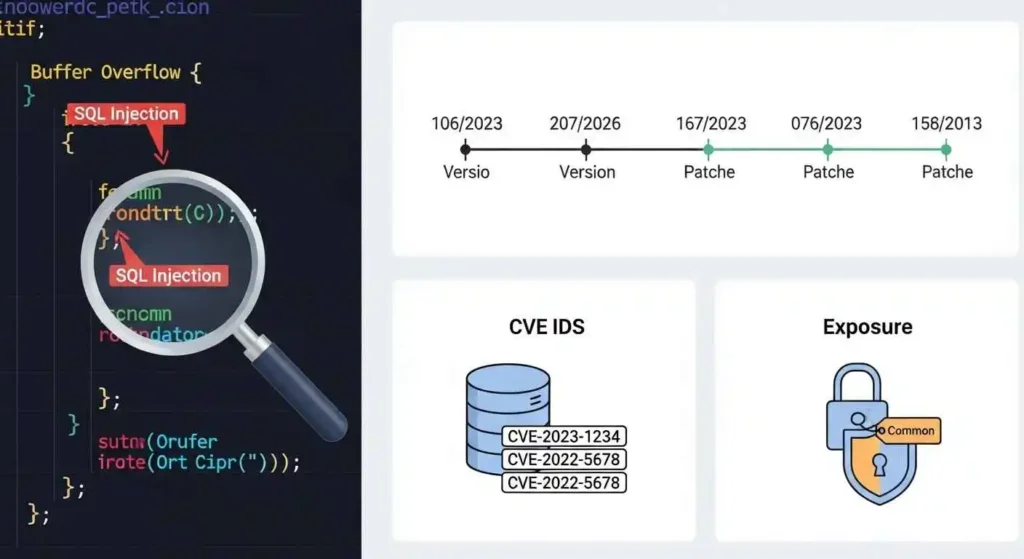What Is CVE in Cyber Security
Consider the following scenario: your small business releases a new app, and its users adore it. A month later, a hacker discovers a secret weakness in the code, exploits it, and steals private information. This story isn’t unique; it’s part of the everyday cybersecurity landscape.
Understanding CVE—Common Vulnerabilities and Exposures—a global framework for monitoring publicly known security issues is essential for staying safe.
This article defines CVE in cybersecurity, provides real-world examples, and outlines how to use CVE information to confidently safeguard your company.
In terms of cybersecurity, what is CVE?
A CVE entry functions similarly to a vulnerability’s “serial number.”
To ensure that everyone, from developers to IT managers, is speaking the same language, each record in the CVE list details a distinct software or hardware vulnerability along with a unique CVE ID.
Consider CVE to be the phone book of cybersecurity vulnerabilities. It offers a single point of reference rather than a plethora of technical terms, allowing vendors, researchers, and security teams to discuss and quickly address any issues that are found.
Examples of CVE to Make It Real
Let’s make it more practical:
The internet was rocked by the logging library flaw CVE-2021-44228 (Log4Shell).
A cross-site scripting vulnerability in web page production is known as CVE-2022-21948.
CVE-2023-22643: incorrect OS command neutralization.
Teams are able to implement the correct patch or workaround without any confusion or delays when these IDs appear in security advisories.
How a CVE ID Is Assigned Step-by-Step
Here’s how a vulnerability is formally designated as a CVE if you ever find one:
Determine the weak point.
Developers or security researchers identify a flaw, such as improperly designed databases or unsafe password management.
Inform a CVE Numbering Authority (CNA) about it.
Get a CVE ID by going to cve.mitre.org.
While you organize a fix, reserve the ID so that it is yours.
Provide information on the impact, impacted items, and references.
For the world to take action, publish the final record.
This straightforward procedure guarantees that each significant fault receives a distinct worldwide identity.
Comprehending the CVE Database
With assistance from the U.S. CISA, the non-profit MITRE Corporation curates the public CVE database, which houses all CVE records.
Security experts often consult the National Vulnerability Database (NVD) for more detailed information, including exploitability metrics, patch links, and severity rankings.
In terms of cybersecurity, what is CVSS?
It’s one thing to identify a vulnerability. Another is to rate its hazard.
The Common Vulnerability Scoring System (CVSS) is useful in this situation.
Each CVE is assigned a CVSS score ranging from 0.0 (none) to 10.0 (critical), which is determined by the vulnerability’s ease of exploitation and potential damage.
9.0 or higher on the CVSS? Fix it right away, just like you would with a fire alarm.
CVE in Compliance and Risk Management
CVE data is used by organizations to maintain compliance with regulations such as HIPAA and PCI DSS.
IT teams can prioritize updates, control risk, and demonstrate compliance with industry standards by monitoring CVEs.
How to Include the CVE List in Your Security Strategy
This is a short plan of action:
Automate scanning: compare your systems to the CVE database using programs like Nessus or OpenVAS.
In order to detect new vulnerabilities, subscribe to MITRE CVE feeds.
Fix quickly by adding CVE warnings to your patch management system.
As a result, attackers have a smaller window of opportunity.
Story: A Small Company Comes to the Rescue
A serious CVE in the shopping cart software nearly caused one retail organization I consulted to lose customer payment data.
They avoided a possible data-breach headline the following morning by identifying the warning within hours and patching it overnight, thanks to their IT manager’s subscription to the CVE list.
That’s what proactive CVE monitoring is all about.
How to Use CVE Data to Boost Your Cybersecurity
Examine CVE data every week rather than waiting for yearly audits.
Employees should be trained to recognize phishing efforts because human error frequently lets them in.
If internal resources are few, collaborate with a managed IT provider with vulnerability management experience.
Are You Prepared to Safeguard Your Company?
In cybersecurity, being aware of CVEs is more than just trivia; it’s your first line of defense against expensive breaches.
Customers will trust you more if you keep an eye on the CVE database, verify CVSS scores, and take prompt action to protect your brand.
Protect your systems right now. Examine the CVE list, evaluate your apps, and confidently make investments in robust cybersecurity solutions.
What is CVE, for instance?
A CVE is a vulnerability that has been cataloged, such as CVE-2021-34527 (PrintNightmare).
In terms of cybersecurity, what is CVSS?
A system of scores to gauge the seriousness of vulnerabilities.
CVE ID: What is it?
Each vulnerability’s unique number (such as CVE-2025-12345).
Where is the CVE database located?
Check out the NVD or the official CVE database.

